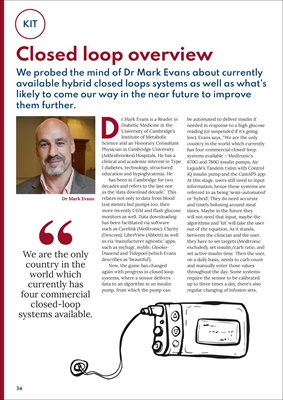
34KIT
Closed loop overview
We probed the mind of Dr Mark Evans about currently
available hybrid closed loops systems as well as what's
likely to come our way in the near future to improve
them further.
Dr Mark Evans.
We are the only
country in the
world which
currently has
four commercial
closed-loop
systems available. Dr Mark Evans is a Reader in
Diabetic Medicine in the
University of Cambridge's
Institute of Metabolic
Science and an Honorary Consultant
Physician in Cambridge University
(Addenbrookes) Hospitals. He has a
clinical and academic interest in Type
1 diabetes, technology, structured
education and hypoglycaemia. He
has been in Cambridge for two
decades and refers to the last one
as the 'data download decade.' This
relates not only to data from blood
test meters but pumps too, then
more recently CGM and flash glucose
monitors as well. Data downloading
has been facilitated via software
such as Carelink (Medtronic), Clarity
(Dexcom), LibreView (Abbott) as well
as via 'manufacturer agnostic' apps,
such as mySugr, mylife, GlookoDiasend and Tidepool (which
Evans
describes as 'beautiful').
Now, the game has changed
again with progress in closed loop
systems, where a sensor delivers
data to an algorithm in an insulin
pump, from which the pump can
be automated to deliver insulin if
needed in response to a high glucose
reading (or suspended if it's going
low). Evans says, "We are the only
country in the world which currently
has four commercial closed-loop
systems available - Medtronic's
670G and 780G insulin pumps, Air
Liquide's Tandem t:slim with Control
iQ insulin pump and the CamAPS app.
At this stage, users still need to input
information, hence these systems are
referred to as being 'semi-automated'
or 'hybrid'. They do need accurate
and timely bolusing around meal
times. Maybe in the future they
will not need that input, maybe the
algorithms and 'kit' will take the user
out of the equation. As it stands,
between the clinician and the user,
they have to set targets (Medtronic
excluded), set insulin/carb ratio, and
set active insulin time. Then the user,
on a daily basis, needs to carb count
and manually enter those values
throughout the day. Some systems
require the sensor to be calibrated
up to three times a day, there's also
regular changing of infusion sets,